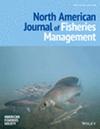Don't count your eggs before they resorb: Early collection of ovarian follicles influences estimates of Lake Trout fecundity in Yellowstone Lake
IF 1.4
4区 农林科学
Q3 FISHERIES
引用次数: 0
Abstract
ObjectiveUnderstanding recruitment dynamics is necessary to predict population‐level responses to exploitation, management actions, or anthropogenic influences. Fecundity is commonly used as a metric of recruitment dynamics and can guide successful management of fisheries. However, an individual female's fecundity is not constant over time; females resorb ovarian follicles to regulate fecundity as they approach spawning. This suggests that sampling for fecundity too early may produce inaccurate estimates of relative fecundity. In Yellowstone National Park, suppression of invasive Lake Trout不要在卵子吸收前计算卵子数量:卵泡的早期采集会影响黄石湖湖鳟繁殖力的估计值
目标 要预测种群对开发、管理行动或人为影响的反应,就必须了解繁殖动态。繁殖力通常被用作衡量繁殖动态的指标,可指导渔业管理取得成功。然而,雌性个体的受精率并不是长期不变的;雌性个体在临近产卵期时会吸收卵泡来调节受精率。这表明,过早进行繁殖力取样可能会导致对相对繁殖力的估计不准确。在黄石国家公园,对入侵湖鳟 Salvelinus namaycush 的抑制使成熟鱼类的数量在 2012 年至 2022 年间减少了 92%。我们试图确定卵泡采集的时间是否会影响平均相对繁殖力的估计值。我们在 2021 年和 2022 年的 8 月中旬至 10 月初采集了秋季产卵的雌性湖鳟的卵巢卵泡。结果我们观察到,在 9 月中旬之前采样的个体与在 9 月中旬之后采样的个体之间,平均相对受精率估计值下降了 13%。结论我们的数据支持对受精率采样时机进行战略性选择,以最好地捕捉种群的真实繁殖能力,这是指导鱼类适应性管理的模型中使用的一个关键指标。
本文章由计算机程序翻译,如有差异,请以英文原文为准。
求助全文
约1分钟内获得全文
求助全文
来源期刊
CiteScore
2.60
自引率
18.20%
发文量
118
审稿时长
2 months
期刊介绍:
The North American Journal of Fisheries Management promotes communication among fishery managers with an emphasis on North America, and addresses the maintenance, enhancement, and allocation of fisheries resources. It chronicles the development of practical monitoring and management programs for finfish and exploitable shellfish in marine and freshwater environments.
Contributions relate to the management of fish populations, habitats, and users to protect and enhance fish and fishery resources for societal benefits. Case histories of successes, failures, and effects of fisheries programs help convey practical management experience to others.

 求助内容:
求助内容: 应助结果提醒方式:
应助结果提醒方式:


